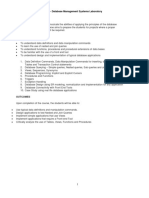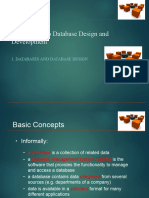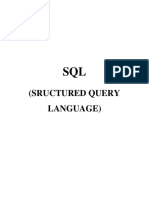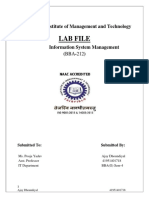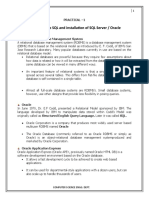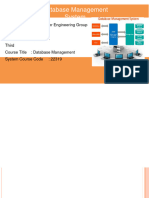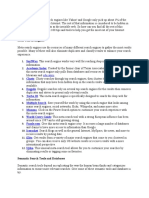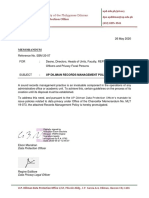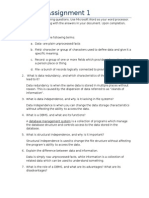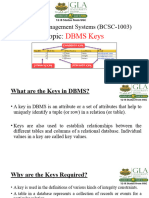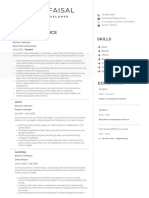Practical File SQL Queries DBMS
Uploaded by
Dharmanand NayakPractical File SQL Queries DBMS
Uploaded by
Dharmanand Nayak1
DBMS & SQL queries
DBMS & SQL
Queries
Session - 2009
-10
Submitted by: Submitted to:
Name: Prabhat Kumar Kanika Mahajan
Class: BCA IInd Concerned Lect. in DBMS
Class Roll no. 06 Ashoka college of Computer
Education
Ashoka College of Computer Education |
2
DBMS & SQL queries
Certificate
This is certified that the
practical file belongs to
Prabhat Kumar, Class roll
no. 06 and Examination
Roll no…………of session
2009-10 and has
completed all the practical
in the college computer lab
under our guidance and his
behavior in the college is
good.
Ashoka College of Computer Education |
3
DBMS & SQL queries
Teacher Incharge
Principal
Index
Ashoka College of Computer Education |
4
DBMS & SQL queries
S. no. Name of practical Remarks
1. Database, DBMS definition
2. Introduction to SQL
3. Components of SQL, Data types
4. SQL Queries create, insertion
5. Create a table
6. Describe the table
7. Insert the values
8. To view the table
9. Sorting the data
10. To rename the table
11. Delete a particular row
12. Lower case
13. Upper case
14. Drop the table
15. Maximum
16. Minimum
17. Average
18. Like
19. Between
20. Primary key
21. Unique key
22. Count
23. Sum
24. Alter
25. Update
Ashoka College of Computer Education |
5
DBMS & SQL queries
Database
A database is an organized collection of facts. In other words, we
can say that it is a collection of information arranged and
presented to serve an assigned purpose.
An example of a database is a dictionary
Database Management System
Database management system, or DBMS, is a computer software
program that is designed as the means of managing all databases
that are currently installed on a system hard drive or network.
Different types of database management systems exist, with
some of them designed for the oversight and proper control of
databases that are configured for specific purposes. Here are
Ashoka College of Computer Education |
6
DBMS & SQL queries
some examples of the various incarnations of DBMS technology
that are currently in use, and some of the basic elements that are
part of DBMS software applications.
As the tool that is employed in the broad practice of managing
databases, the DBMS is marketed in many forms. Some of the
more popular examples of DBMS solutions include Microsoft
Access, FileMaker, DB2, and Oracle. All these products provide for
the creation of a series of rights or privileges that can be
associated with a specific user. This means that it is possible to
designate one or more database administrators who may control
each function, as well as provide other users with various levels of
administration rights. This flexibility makes the task of using
DBMS methods to oversee a system something that can be
centrally controlled, or allocated to several different people.
Introduction to Structured Query
Language (SQL)
Structured query language is a language that provides an
interface to relational database systems. SQL was developed by
IBM in the 1970s for use in system R, and is a de facto standard,
as well as an ISO and ANSI standard. SQL is often pronounced
SEQUEL.
SQL has been a command language for communication with the
oracle 9i server from any tool or application. Oracle SQL contains
many extensions. When an SQL statement is entered, it is stored
in a part of memory called the SQL buffer and remains there until
a new SQL statement is entered.
Ashoka College of Computer Education |
7
DBMS & SQL queries
Features of Structured query language (SQL)
SQL can be used by a range of users, including those with little or
no programming experience.
• It is a nonprocedural language.
• It reduces the amount of time required for creating and
maintaining systems.
• It is English like language.
Components of SQL
1) DDL (Data Definition Language):- It is a set of SQL commands
used to create, modify and delete database structures but not data.
They are normally used by the DBA not by user to a limited extent, a
database designer or application developer. These statements are
immediate i.e. they are not susceptible to ROLLBACK commands. It
should also be noted that if several DML statements for example
UPDATES are executed then issuing any DDL command would COMMIT
all the updates as every DDL command implicitly issues a COMMIT
command to the database. Anybody using DDL must have the CREATE
object privilege and a table space area in which to create objects.
For example: - CREATE, ALTER, DROP, TRUNCATE, COMMENT etc.
2) DML (Data Manipulation Language):- It is the area of SQL
that allows changing data within the database.
Examples:-INSERT, UPDATE, DELETE etc.
Ashoka College of Computer Education |
8
DBMS & SQL queries
3) DCL (Data Control Language):- It is the component of SQL
statement that control access to data and to the database. Occasionally
DCL statements are grouped with DML statements.
Examples: - COMMIT, SAVEPOINT, ROLLBACK etc.
4) DQL (Data Query Language):- It is the component of SQL
statement that allows getting data from the database and imposing
ordering upon it. It includes the SELECT statement. This command is the
heart of SQL. It allows getting the data out of the database perform
operations with it. When a SELECT is fired against a table or tables the
results is compiled into a further temporary table, which is displayed or
perhaps received by the program i.e. a front-end.
Examples: - SELECT retrieve data from the database.
Oracle data types
Data types come in several forms and sizes, allowing the programmer to
create tables suited to the scope of the project. The decisions made in
choosing proper data types greatly influence the performance of a database.
The information in the database is maintained in the form of tables and each
table consists of rows and columns, which store data and therefore this data
must have some data type i.e. the type of data, which is stored in the table.
The different types of data types in Oracle are:-
• CHAR
• VARCHAR (size) or VARChAR2 (size)
• NUMBER
• DATE
• LONG.
CHAR: - This data types is used to store character strings
values of fixed length. The size in brackets determines the
number of characters the cell can hold. The maximum number
of characters (i.e. the size) this data type can hold is 255
Ashoka College of Computer Education |
9
DBMS & SQL queries
characters. The data held is right- padded with spaces to
whatever length specified.
VARCHAR or VARCHAR2:- This data type is used to store
variable length alphanumeric data. It is a more flexible form of
the CHAR data type. The maximum this data type can hold up
to 4000 characters. One difference between this data type and
char data type is oracle compares varchar values using non
padded comparison semantics i.e. the inserted values will not
be padded with spaces. VARCHAR can hold 1 to 255
characters. Varchar is usually a wiser choice than char due to
its variable length format characteristics but keep in mind that
char is much faster than varchar sometimes up to 50%.
NUMBER: - The number data type is used to store numbers
(fixed or floating point).The precision (P) determines the length
of the data while(s), the scale, determines the number of
places after the decimal. The NUMBER data type that is used
to store number data can be specified either to store integers
or decimals with the addition of a parenthetical precision
indicator. If we do not use then the default value is 0 and if we
don’t use precision then by default value stored can be of 38
digits.
DATE:- The DATE data type stores date and time information.
Although date and time information can be represented in both
character and number data types, the DATE data type has
special associated properties. For each DATE value, Oracle
stores the following information: century, year, month, date,
hour, minute, and second.
LONG:- LONG columns store variable-length character strings
containing up to 2 gigabytes, or 231-1 bytes. LONG columns
have many of the characteristics of VARCHAR2 columns. You can
use LONG columns to store long text strings. The length of LONG
values may be limited by the memory available on your
computer
Ashoka College of Computer Education |
10
DBMS & SQL queries
The use of LONG values is subject to some restrictions:
• A table can contain only one LONG column.
• You cannot create an object type with a LONG attribute.
• LONG columns cannot appear in WHERE clauses or in integrity constraints
(except that they can appear in NULL and NOT NULL constraints).
• LONG columns cannot be indexed.
• A stored function cannot return a LONG value.
• You can declare a variable or argument of a PL/SQL program unit using the
LONG datatype. However, you cannot then call the program unit from SQL.
• Within a single SQL statement, all LONG columns, updated tables, and locked
tables must be located on the same database.
QUERY
A query is a concise memo submitted to an editor by a writer seeking
publication. It is basically an in query to see whether the writer’s work is of
interest to a particular publication. A query briefly details a writer’s experience
and knowledge of the subject matter, and gives a summary or synopsis of the
article the writer hopes to have published. An approximate word count for the
proposed article or feature is also generally included.
1) THE CREATE TABLE COMMAND :- The CREATE TABLE command
defines each
column of the table uniquely. Each
column has a minimum of three attributes, a name, data type and
size (i.e. column width).
Syntax: - CREATE TABLE<table name>(<column Name 1> <data
type>(<size>), <columnname2> <data type>(<size>));
Example:
SQL> create table student(name varchar(23),roll_no number(12),class
varchar2(12),address varchar(23));
Table created.
2) THE INSERTION OF DATA INTO TABLE: - Once a table is created, the
most natural thing to do is
load this with data to be manipulated later i.e. to insert the rows in
a table. The data in a table can be inserted in three ways.
Syntax:-INSERT INTO <table name >(<columnname1>,<columnname2>)
VALUES(<expression1>,<expression 2>);
Ashoka College of Computer Education |
11
DBMS & SQL queries
OR
INSERT INTO <tablename>VALUES(<expression1 >,<expression2> );
OR
INSERT INTO <tablename> VALUES(‘<&columnname1>’ ,’<&columnname2>’);
Example:-
SQL> insert
intostudent(name,roll_no,class,address)values('Prabhat',06,'BCA',Hat
limore');
1 row created.
Or
SQL> insert into student values('kishore',01,'BCA','Nagri');
1 row created.
Or
SQL> insert into student
values('&name','&roll_no','&class','&address');
Enter value for name: Amarjeet
Enter value for roll_no: 30
Enter value for class: BCA
Enter value for address: airwan
old 1: insert into student
values('&name','&roll_no','&class','&address')
new 1: insert into studen values('Atinder','04','BCA','Sawan
chack')
1 row created.
FOR inserting more values we use ‘/’ slash after SQL> as below but
after above syntax used:
SQL> /
Enter value for name: Vinay
Ashoka College of Computer Education |
12
DBMS & SQL queries
Enter value for roll_no: 08
Enter value for class: BCA
Enter value for address: Barnoti
old 1: insert into student
values('&name','&roll_no','&class','&address')
new 1: insert into studen values('Vinay','08','BCA','Barnoti')
1 row created.
3) FOR VIEWING DATA IN THE TABLE: - Once data has been inserted
into a table, the next most logical
operation would be to view what has been inserted. The SELECT
SQL verb is used to achieve this. The SELECT command is used to
retrieve rows selected from one or more tables.
Syntax: - SELECT * FROM <table name>;
If we want to see all the tables that are already exist in the database .we use
SELECT * FROM TAB;
Example:-
SQL> select * from student;
NAME ROLL_NO CLASS ADDRESS
----------------------- ---------- ------------ ----------
Prabhat 06 BCA Hatlimore
Kishore 01 BCA Nagri
Amarjeet 30 BCA airwan
Vinay 08 BCA barnoti
1 row created.
When we use the command SELECT* FRM TAB; the output is displayed as:-
Ashoka College of Computer Education |
13
DBMS & SQL queries
SQL> select * from tab;
TNAME TABTYPE CLUSTERID
------------------------------ ------- ----------
ABC TABLE
ANKU TABLE
BONUS TABLE
DEPARTMENTS TABLE
DEPT TABLE
EMP TABLE
EMPLOYEE TABLE
EMPLOYEES TABLE
STUDENT TABLE
9 rows selected.
4) ELIMINATION OF DUPLICATE ROWS :- A table could hold duplicate
rows in such a case, only
unique rows the distinct clause can be used.
Syntax: - SELECT DISTINCT <column name 1>,<column name2> FROM
<table name> ;
This syntax will give the unique values of column 1 and column 2.
Example:-
SQL> select distinct name,roll_no from student;
NAME ROLL_NO
-------------------- ----------
Ashoka College of Computer Education |
14
DBMS & SQL queries
Prabhat 06
Syntax:- SELECT DISTINCT * from <tablename>;
Example:-
SQL> Select DISTINCT * from student;
NAME ROLL_NO CLASS ADDRESS
------------------ -------- ------------ ----------
Prabhat 06 BCA Hatlimore
5) SORTING DATA IN A TABLE: - Oracle allows data from a table to be
viewed in
sorted order. The rows retrieve from
the table will be sorted either in ascending or descending order
depending on the condition specified in the select sentence.
Syntax: - SELECT * FROM <tablename>ORDER BY<column name1>,<column
name 2> <[sort order]>;
Example:-
SQL> SELECT * FROM STUDENT ORDER BY name;
NAME ROLL_NO CLASS ADDRESS
----------------------- ---------- ------ ---------------
Amarjeet 30 BCA airwan
Atinder 04 BCA sawanchak
Dushyant 34 BCA jagatpur
Kishore 01 BCA Nagri
Prabhat 06 BCA Hatlimore
Vinay 08 BCA barnoti
Ashoka College of Computer Education |
15
DBMS & SQL queries
6 rows selected
SQL> SELECT*FROM STUDENT ORDER BY name desc;
NAME ROLL_NO CLASS ADDRESS
----------------------- ---------- ------------ --------------
Vinay 08 BCA barnoti
Prabhat 06 BCA Hatlimore
Kishore 01 BCA Nagri
Dushyant 34 BCA jagatpur
Atinder 04 BCA sawanchak
Amarjeet 30 BCA airwan
6 rows selected.
SQL> SELECT * FROM STUDEN ORDER BY roll_no desc;
NAME ROLL_NO CLASS ADDRESS
----------------------- ---------- ------------ ---------------
Kishore 01 BCA Nagri
Atinder 04 BCA sawanchak
Prabhat 06 BCA Hatlimore
Ashoka College of Computer Education |
16
DBMS & SQL queries
Vinay 08 BCA barnoti
Amarjeet 30 BCA airwan
Dushyant 34 BCA jagatpur
6 rows selected.
6) MODIFYING THE STRUCTURE OF TABLES: - The structure of a table
can be
modified by using the ALTER
TABLE command. ALTER TABLE allows changing the structure of an
existing table. With ALTER TABLE it is possible to add or delete columns,
create or destroy indexes, changes the data type of existing columns, or
rename columns or the table itself.
(a) ADDING NEW COLUMNS
Syntax: - ALTER TABLE <Table name> ADD(<New column Name> <data
type> (<size>),<new column name><data type>(<size>)….);
Example:-
(b) DROPPING A COLUMN FROM A TABLE
Syntax: - ALTER TABLE<TABLE NAME>DROP COLUMN<COLUMNNAME>;
Example:- alter table prabhu drop column name;
(c) MODIFYING EXISTING COLUMNS
Syntax: - ALTER TABLE<Table name>MODIFY(<COLUMN NAME> <NEW
DATATYPE>(<NEW SIZE>));
Example:- alter table prabhat modify(name varchar(22));
Ashoka College of Computer Education |
17
DBMS & SQL queries
7) RENAMING TABLES: - Oracle allows renaming of tables. The rename
operation is done atomically, which means
that no other thread can access any of the tables while the rename process
is running.
Syntax: - RENAME <Table name> to <New Tablename>
Example:-
SQL> rename student to candidates;
Table renamed.
8) DESTROYING TABLES:-
• DROP COMMAND: - By using the DROP TABLE statement with the table name
we can destroy a specific table .
Syntax: - DROP TABLE <table name>;
Example:--
SQL> Drop table student;
Table dropped.
• TRUNCATE COMMAND:- The truncate command is much faster in comparison
to delete
statement but similar to the drop command as to
destroy a specific table.
Syntax:- TRUNCATE table <tablename>
Example:-
SQL> truncate table employees;
Table truncated.
Ashoka College of Computer Education |
18
DBMS & SQL queries
9) DISPLAYING THE TABLE STRUCTURE:- To display information about
the columns defined in a
table use the following syntax.
Syntax: - DESCRIBE <table name>
This command displays the columns names, the data types and the
special attributes connected to the table.
Example: -
SQL> describe employees;
Name Null? Type
---------------------------------- -------- -----------
EMP_ID NUMBER(5)
EMP_NAME VARCHAR2(20)
DEPT_ID NUMBER(10)
DEPT_NAME NAME(12)
SALARY NUMBER(21)
10) UPDATING THE CONTENTS OF A TABLE: - The update command is
used to change or modify
data values in a table. The verb UPDATE in SQL is used to either all the
rows from a table or a select set of rows from a table.
• UPDATING ALL ROWS:- The update statement updates columns in the
existing table’s rows
with new values .The SET clause indicates which
column data should be modifying and the new values that they should hold.
The WHERE CLAUSE specifies which rows should be updated. Otherwise all
table rows are updated.
Syntax: - UPDATE < Table name> SET <column name1>=<expression1> ,
<column name2>=<expression2>;
Ashoka College of Computer Education |
19
DBMS & SQL queries
• UPDATES RECORDS CONDITIONALLY:-
Syntax :- UPDATE <table name> SET <columnname1> = <expression1>,
<columnname2> = <expression2> WHERE <condition>;
CONSTRAINTS
11) NOT NULL:- The NOT NULL column constraint ensures that a
table column cannot be left
empty. When a column is defined as not null, then that
column becomes a mandatory column. It implies that a value must be
entered into the column if the record is to be accepted for storage in the
table.
Syntax:- <Column Name> <data type>(<size>) NOT NULL ;
Example:-name varchar(22) not null;
THE PRIMARY KEY CONSTRAINT: - A primary is one or more column
in a table
used to identify each row in a table. None of
the fields that are part of the primary key can contain a null value. A table
can have only one primary
Syntax:- <Column name> <data type>(<size>) PRIMARY KEY
Example:-
SQL> create table student name varchar2(12), roll_no
number(12) primary key, class varchar2(21) NOT NULL, dob
date);
or
Ashoka College of Computer Education |
20
DBMS & SQL queries
SQL> create table student(name varchar2(12), roll_no
number(12) constraint pk_roll primary key ,class varchar2(21)
not null, dob date);
12) THE FOREIGN KEY (SELF REFERENCE) CONSTRAINT:-Foreign
key represent
relatio
nships between tables. A foreign key is a column (or a group of columns)
whose values are derived from the primary key or unique key of some other
table. The table in which the foreign key is defined is called a FOREIGN
TABLE or DETAIL TABLE. The table that defines the primary or unique key
and is referenced by the foreign key is called the PRIMARY KEY or MASTER
KEY.
Syntax: - Foreign key (<column name>) REFERENCES <table
name>(column name);
Example:-
SQL> create table department(dept_no number(10) primary
key,dept_name varchar2(25),dept_loc char(5,e_no number(11),
foreign key(e_no) references employee (e_no);
Table created
SQL> describe department;
Name Null? Type
-------------------------- -------- -------
DEPT_NO NOT NULL NUMBER(10)
DEPT_NAME VARCHAR2(25)
DEPT_LOC CHAR(5)
E_NO NUMBER(11).
Ashoka College of Computer Education |
21
DBMS & SQL queries
13) THE UNIQUE KEY CONSTRAINT:- The unique key constraint
permits multiple
entries of NULL into the column. These NULL
values are clubbed at the top of the column in the order in which they were
entered into the table. This is the essential difference between the primary
key and the unique constraints when applied to table column(s). Key point
about UNIQUE constraint:
• Unique key will not allow duplicate values.
• Unique index is created automatically.
• A table can have more than one unique key which is not possible in
primary key.
Syntax:- CREATE TABLE Table name (<columnName1>
<datatype>(<size>), <columnName2> <data
type>(<size>),UNIQUE(<columnName1>, <columnName2>));
Example:-
SQL> create table student1(roll_no number(12)primary key,dob
date,name varchar2(20),class varchar2(2),e_mail varchar2(20)
constraint un_st unique);
Table created.
To see the description of the table.
SQL> Describe student1;
Name Null? Type
--------------------------------- -------- ----------
Ashoka College of Computer Education |
22
DBMS & SQL queries
ROLL_NO NOT NULL NUMBER(12)
DOB DATE
NAME VARCHAR2(20)
CLASS VARCHAR2(20)
E_MAIL VARCHAR2(20)
ORACLE FUNCTIONS
Oracle functions serve the purpose of manipulating data items and
returning a result. Functions are the programs that take zero or more
arguments and return a single value. Oracle has built a no. of functions into
SQL. These functions can be called from SQL statements.
14) COUNT (expr) function: - Returns the number of rows where
expression is not null.
Syntax: - COUNT ([<distinct>[<all>] <expr>)
Example:-
EMP_ID NAME DEPT_ID SALARY
--------- -------------------- ---------- ----------
1 sourabh 21 55000
2 sonu 22 55000
3 anku 4 55000
5 anku 21 55000
3 panku 22 75000
SQL> select count(distinct name) from employees;
Ashoka College of Computer Education |
23
DBMS & SQL queries
COUNT(DISTINCTNAME)
-------------------
SQL> select count(salary) from employees;
COUNT(SALARY)
----------
15) COUNT (*) function: - Returns the number of rows in the table,
including duplicates and those with nulls.
Syntax: - COUNT(*)
Example:-
SQL> select count(*) from employees;
COUNT(*)
----------
SQL> select count(*)"salary" from employees;
salary
----------
Ashoka College of Computer Education |
24
DBMS & SQL queries
16) THE SUM FUNCTION: - Returns the sum of the values of ‘n’.
Syntax: - SUM ([<distinct>][<all>] <expr>)
Example:-
SQL> select sum (salary) from employees;
SUM(SALARY)
-----------
295000
17) THE MAX FUNCTION: - Returns the maximum value of expression.
Syntax: - MAX([<distinct>][<all>] <expr>)
Example:-
SQL> select max(salary) from employees;
MAX(SALARY)
-----------
75000
18) THE MIN FUNCTION: - Returns the minimum value of expression.
Syntax: - MIN ([<distinct>][<all>] <expression>)
Example:-
SQL> select min (salary) from employees;
Ashoka College of Computer Education |
25
DBMS & SQL queries
MIN(SALARY)
-----------
55000
19) THE AVG FUNCTION: - Returns an average value of ‘n’, ignoring null
values in a column.
Syntax: - AVG ([<distinct>][<all>] <n>);
Example:-
SQL> select avg(salary) from employees;
AVG(SALARY)
-----------
59000
20) LIKE OPREATOR :- The LIKE predicate allows comparison of one
string value with
another string value, which is not identical. This is
achieved by using wildcard characters. Two wildcard characters that are
available are:
• % allows to match any string of any length(including zero length)
• _allows to match on a single character.
Example:-
SQL> select emp_id,name,dept_id,salary from employees where
name like 'a%';
Ashoka College of Computer Education |
26
DBMS & SQL queries
EMP_ID NAME DEPT_ID SALARY
------ ------- ----------- ---------
3 anku 4 55000
5 anku 21 55000
• NOT LIKE OPERATOR:-
Example:-
SQL>select emp_id,name,dept_id,salary from employees where
name not like 'a%';
EMP_ID NAME DEPT_ID SALARY
--------- --------------- ---------- ----------
1 sourabh 21 55000
2 sonu 22 55000
3 panku 22 75000
SQL>select emp_id,name,dept_id,salary from employees where
name like '_n_u';
EMP_ID NAME DEPT_ID SALARY
---------- ---------------- ---------- ----------
3 anku 4 55000
5 anku 21 55000
Ashoka College of Computer Education |
27
DBMS & SQL queries
21) IN OPERATOR:- In case a value needs to be compared to a list
of values then the IN
predicate is used. The IN predicates helps reduce the
need to use multiple OR conditions.
Example:-
SQL> select emp_id,name,dept_id,salary from employees where
dept_id in(20,22);
EMP_ID NAME DEPT_ID SALARY
---------- -------------------- ---------- ----------
2 sonu 22 55000
3 panku 22 75000
• NOT IN OPERATOR:-
Example :-
SQL>select emp_id,name,dept_id,salary from employees where
dept_id not in(20,22);
EMP_ID NAME DEPT_ID SALARY
-------- -------------------- ---------- ----------
1 sourabh 21 55000
3 anku 4 55000
5 anku 21 55000
22) BETWEEN OPERATOR:-
Ashoka College of Computer Education |
28
DBMS & SQL queries
SQL> select emp_id,name,dept_id,salary from employees where
dept_id between 22 and 30;
EMP_ID NAME DEPT_ID SALARY
--------- -------------------- ---------- ----------
2 sonu 22 55000
3 panku 22 75000
SQL>select emp_id,name,dept_id,salary from employees where
dept_id between 11 and 21;
EMP_ID NAME DEPT_ID SALARY
--------- -------------------- ---------- ----------
1 sourabh 21 55000
5 anku 21 55000
STRING FUNCTIONS
23) UPPER function :- Returns char, with all letters forced to
uppercase.
Ashoka College of Computer Education |
29
DBMS & SQL queries
Syntax: - UPPER(char)
Example: -
SQL> select upper(name) from employees;
UPPER(NAME)
--------------------
SOURABH
SONU
ANKU
ANKU
PANKU
24) LOWER function: - Returns char, with all letters in lowercase.
Syntax: - LOWER(char)
Example:-
SQL> select lower(name) from employees;
LOWER(NAME)
--------------------
sourabh
sonu
anku
anku
Ashoka College of Computer Education |
30
DBMS & SQL queries
panku
25) INITCAP function: - Returns a string with the first letter of
each word in upper case.
Syntax:- INITCAP(char)
Example:-
SQL> select initcap(name) from employees;
INITCAP(NAME)
--------------------
Sourabh
Sonu
Anku
Anku
Panku
Ashoka College of Computer Education |
You might also like
- DBMS & SQL Queries: Submitted By: Submitted ToNo ratings yetDBMS & SQL Queries: Submitted By: Submitted To22 pages
- A Program Lab Report On: Bachelor of Computer ApplicationsNo ratings yetA Program Lab Report On: Bachelor of Computer Applications21 pages
- CS8481 - Database Management Systems Lab ManualsairamNo ratings yetCS8481 - Database Management Systems Lab Manualsairam160 pages
- EContent 2 2024 08 22 19 20 19 DBMSLABMANUALpdf 2024 07 16 16 18 25No ratings yetEContent 2 2024 08 22 19 20 19 DBMSLABMANUALpdf 2024 07 16 16 18 2549 pages
- Unit-II: - SQL Statements & Working With Tables: MIT College of C.S. & I.T., BasmathNo ratings yetUnit-II: - SQL Statements & Working With Tables: MIT College of C.S. & I.T., Basmath16 pages
- System Vulnerability Assessment On SQL InjectionNo ratings yetSystem Vulnerability Assessment On SQL Injection35 pages
- 01 Basic SQL Commands Final DDL DML DCLNo ratings yet01 Basic SQL Commands Final DDL DML DCL20 pages
- Guru Gobind Singh Indraprastha UniversityNo ratings yetGuru Gobind Singh Indraprastha University51 pages
- UG - B.Sc. - Computer Science - 130 54 - Relational Database Management Systems - Binder - 8455No ratings yetUG - B.Sc. - Computer Science - 130 54 - Relational Database Management Systems - Binder - 845596 pages
- Introduction To SQL, SQL Plus, and SQL DeveloperNo ratings yetIntroduction To SQL, SQL Plus, and SQL Developer32 pages
- Structured Query Language Is The Language Used by DBA and Programmers For Accessing Data From A DatabaseNo ratings yetStructured Query Language Is The Language Used by DBA and Programmers For Accessing Data From A Database45 pages
- 100 Useful Tips and Tools To Research Deep Web100% (1)100 Useful Tips and Tools To Research Deep Web7 pages
- Data Protection Office: University of The Philippines DilimanNo ratings yetData Protection Office: University of The Philippines Diliman10 pages
- ZeosDocumentationCollection 2017 03 20 PDFNo ratings yetZeosDocumentationCollection 2017 03 20 PDF85 pages
- Social Media For Government - A Practical Guide To Understanding, Implementing, and Managing Social Media Tools in The Public Sphere PDFNo ratings yetSocial Media For Government - A Practical Guide To Understanding, Implementing, and Managing Social Media Tools in The Public Sphere PDF174 pages
- The "Magic Number 5": Is It Enough For Web Testing?No ratings yetThe "Magic Number 5": Is It Enough For Web Testing?2 pages
- React Native Developer & Project Manager ExperienceNo ratings yetReact Native Developer & Project Manager Experience1 page
- Data Integration Ebook Version 1 - UpdatedNo ratings yetData Integration Ebook Version 1 - Updated16 pages
- Information Systems and Knowledge ManagementNo ratings yetInformation Systems and Knowledge Management37 pages














